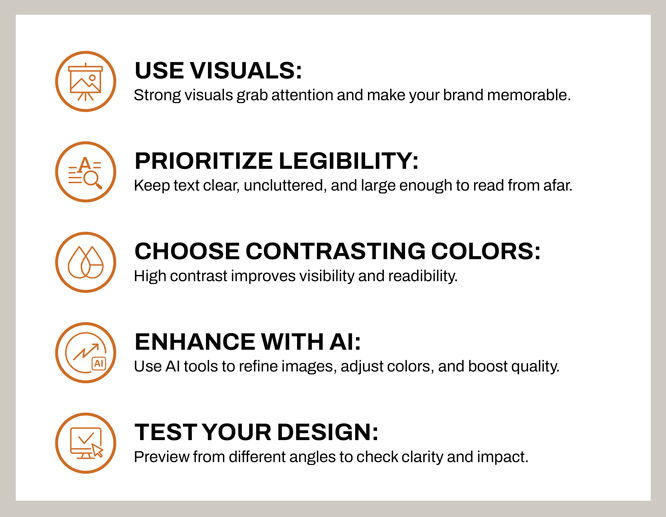How to Make Your Own Sign
Making your own sign is a great opportunity for business owners and hobbyists alike. Studies show that businesses benefit greatly from well-designed signs. If strategically placed, professional signage becomes your brand’s lighthouse, a silent messenger promoting your services or highlighting sales. If you don’t own a business but want to fill your leisure time with creativity, working on your own DIY project can fulfill that desire. Read on if you want to learn how to make your own sign for professional or personal use.
How to Start Making Signs
You need to take a few points into consideration before you start your custom sign-making project.
Purpose: First, you need to decide what your project is about. This crucial decision will determine the rest of the points of how to make a sign, such as its placement and material. Maybe it’s an old-fashioned salon that needs new imagery to draw more customers in, or a newly opened store that will gain considerable advantages from noticeable signage. It all depends on the purpose your signage will serve.
Location: The next important step is deciding whether your signage project will be displayed outdoors or indoors. This is essential because it affects the selection of the material, size, installation, and more.
Material: Once you’re clear with the two above-mentioned points, you need to start thinking about your sign’s material. If it’s an outdoor sign, you’ll need resilient, weather-resistant materials, such as aluminum or acrylic. If it requires an indoor placement, softer materials such as paper or styrene will work.
Duration of Usage: This refers to whether the signage project will be temporary or a permanent installation. There are specific signage types, designed for either short or long-term use, and defining the intended use period will influence your choice. For example, if you’re organizing a birthday party and want to have a striking decorative spot for a photoshoot, then a temporary birthday backdrop will set the stage for capturing memorable moments. If you want to refresh your bakery store’s design, storefront signs are worth considering for permanent brand exposure.

Professional vs DIY: What is Right for You
The idea of making your own sign can be exciting, but it’s important to understand the process to achieve great results. The first step is deciding whether you want to tackle it as a DIY project or work with a professional sign-making company. Each option has its pros and cons, and knowing them will help you choose the right path.
DIY sign-making project:
Pros:
- Cost-saving in the short term;
- Complete creative control.
Cons:
- Signs may be lower in quality;
- Less durable materials;
- Non-professional appearance;
- Additional expenses for tools, if you don’t already have them;
- Can be time-consuming.
Professional Signage Companies:
Pros:
- Premium-quality signs thanks to high-end sign-making technologies;
- Professional-grade look;
- More durable signs than DIY projects;
- Longer lifespan compared to self-made signs;
- Access to an online design tool with tons of designs;
- Saves time and effort.
Cons:
- Higher up front costs;
- Revisions may be limited.
How to Make Simple Signs
If you choose to make a sign on your own, here are a few things to consider before starting the process.
Step 1. Plan the Concept: First and foremost, you should plan a concept. Here, you need to define the type of message you want to convey as well as your audience.
Step 2. Choose and Get the Material: Select and gather the base material, such as wood, aluminum, or foam board, on which the project will be implemented. After that, it’s time for paints and markers.
Step 3. Decide the Design: Sketch out the design, colors, and fonts before starting the process.
Step 4. Get the Tools and Supplies: Without them, you cannot complete your project. Prepare knives, scissors, brushes, stencils, and other tools required for DIY projects.
Step 5. Cut the Design: After the initial layout, you need to carefully cut out the shapes, letters, or other patterns of your signage design.
Step 6. Finish and Place the Design: Place your sign in the intended place. For more protection, cover it with sealant or varnish, especially for outdoor designs.
How to Make Custom Professional Signs
If you’re wondering how to make a personalized sign with a professional sign-making company, you need to keep a few things in mind.
Tools That Make Sign Design Simple
The industry offers many powerful programs, but we know the best results come from accessible platforms. These are the most effective online design tools that will make your sign-crafting process easier.
- Square Signs: This specialized platform gives you the opportunity to create different types of signage designs and choose from professional printing options. You can also find and choose ready-to-use templates for all industries.
- Canva: This is a user-friendly graphic design tool with drag-and-drop features. It’s especially useful for those who do not know how to make a custom sign online with quick steps and are using such tools for the first time.
- Adobe Express: This is a powerful design software with advanced customization options. It’s best for professionals who want more control over typography, branding, and visual effects.
- Loom Signs: Use this dedicated sign-making tool to simplify the design-to-order process. It offers practical solutions for personal and business signage needs. Here, as well, you can find many sign template examples created for countless uses.
Tips to Make Quality Custom Signs
Here are some essential tips to consider while making signs.

FAQ
What material can I use to make a sign?
The material you choose depends on where the signage will be used and how long you want it to last. For outdoor signs, durable options like acrylic, metal, or PVC work best. For indoor signs, lightweight materials like foam board, paper, or styrene work well for short-term or decorative purposes.
How can I make a sign stand out?
Use bold colors, clear fonts, and eye-catching visuals. High contrast between text and background will make your sign readable from a distance. Adding unique shapes, textures, or creative graphics can also help draw attention.
How can I design my own sign?
Start with a sketch of your layout and pick colors that match your brand or theme. Online design tools like SquareSigns, Canva, or Loom Signs make it easy to create professional-looking designs.
What size should my sign be?
It depends on the viewing distance and the location where you’re going to install your sign. Larger signs are easier to read from far away, while smaller signs work well for close-up areas.

